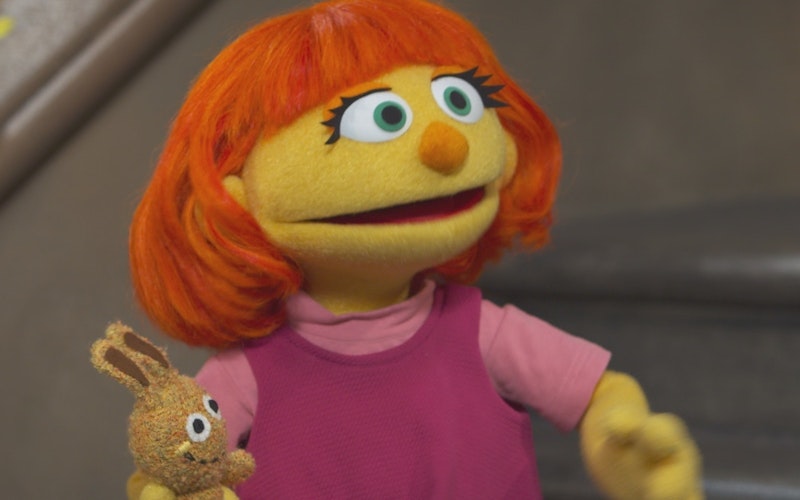
TV
Julia: Sesame Street’s New Image-Bearer
In some ways, she is another young celebrity making the promotional rounds on various talk shows. Last month, she made her television debut on 60 Minutes. Since then, she has been generating great buzz, with a variety of radio and TV appearances, including National Public Radio, CNN, and the BBC, as well as articles in The New York Times, The Los Angeles Times, People, and more.
However, this actor, Julia, is neither typical nor neurotypical. She has autism and is the first new muppet to debut on the children’s show, Sesame Street, in 10 years. Julia already has her own collection of videos on Sesame Street’s YouTube channel, as well as her own fan page on a Muppet Wiki. Both Julia’s creator, Leslie Kimmelman, and her puppeteer, Stacey Gordon, are mothers who have children with autism.
Julia first came to life in a Sesame Street digital storybook, We’re Amazing, 1, 2, 3!, which shows two other Sesame Street characters, Elmo and Abby, playing with Julia in a way that accepts her own way of interacting. In a video segment, Elmo explains that Julia “sometimes does things a little differently.”
Sesame Street creatives worked for nine months and consulted with 14 major autism organizations to plan out Julia’s characteristics, which include echolalia, hand-flapping, and slow or unexpected responses to others. Many people with autism exhibit these behaviors; however, as a female Julia breaks one common stereotype of autism. Although nearly five times as many boys have autism as girls, Sherrie Westin, a Sesame Street executive, says, “We’re trying to eliminate misconceptions, and a lot of people think that only boys have autism.”
Julia gives Sesame Street another opportunity to talk about difference in a way that’s respectful and engaging rather than frightening. The approach is positive rather than pitying. As they adjust to Julia’s differences, the other characters enjoy playing with Julia. Julia loves to sing and remembers song lyrics better than the other characters. Julia makes her own unique and positive contribution to the Sesame Street family. The show never calls on Julia to represent all people with autism spectrum disorder; rather, she is one 4-year-old with autism.
God values every person as an image-bearer.
Gordon, Julia’s puppeteer, wishes that Julia had been around years ago, when her son was “Sesame Street age.” She told60 Minutes, “Had my son’s friends been exposed to his behaviors through something that they had seen on TV before they experienced them in the classroom, they might not have been frightened. And [they] would have known that he plays in a different way, and that that’s OK.”
Many people who have autism do not self-identify as having a disability, and those voices were heard in Julia’s creation. Interactions of Sesame Street’s characters with Julia emphasize difference and diversity, not disability. This parallels the biblical principle that God values every person as an image-bearer, and that the people who seem to be weaker are indispensable. God works through unexpected means, including people who interact with others a little differently, whose senses perceive in different ways, who repeat other’s words, and who express joy (or stress) through hand-flapping or jumping.
Considering the patriarchal, ethnocentric nature of a society like ancient Israel, the inclusion of several women, including two foreigners, in the genealogy of Jesus offers evidence of God’s surprising choices for those through whom he works. The stories of Tamar, Rahab, Ruth, and Bathsheba suggest the same. God pushes all of us to see beyond the boundaries of what we consider acceptable or appropriate and shines a light on his work in doing something new.
In a lovely YouTube segment called “Butterfly Flapping Fun,” Abby and Julia decide to play together. Abby makes several suggestions, but none of Abby’s ideas interest Julia. Abby tells Julia that it’s OK, then Abby turns to the camera and says, “Sometimes friends like different things, so it can be hard to figure out what to play together. But you know what would help? To find something you both want to do.” As Abby watches Julia flapping her hands, Abby suggests that they flap together, and imagine that they are butterflies. Instead of getting frustrated with Julia, Abby discovers that she can have fun by following Julia’s lead.
Jesus called us to love one another, and that includes listening to, appreciating, and following the lead of others—including people with autism. I’m thankful that Sesame Street has made it just a little easier for kids to do that.
Topics: TV, Culture At Large, Arts & Leisure, Home & Family, Parenting